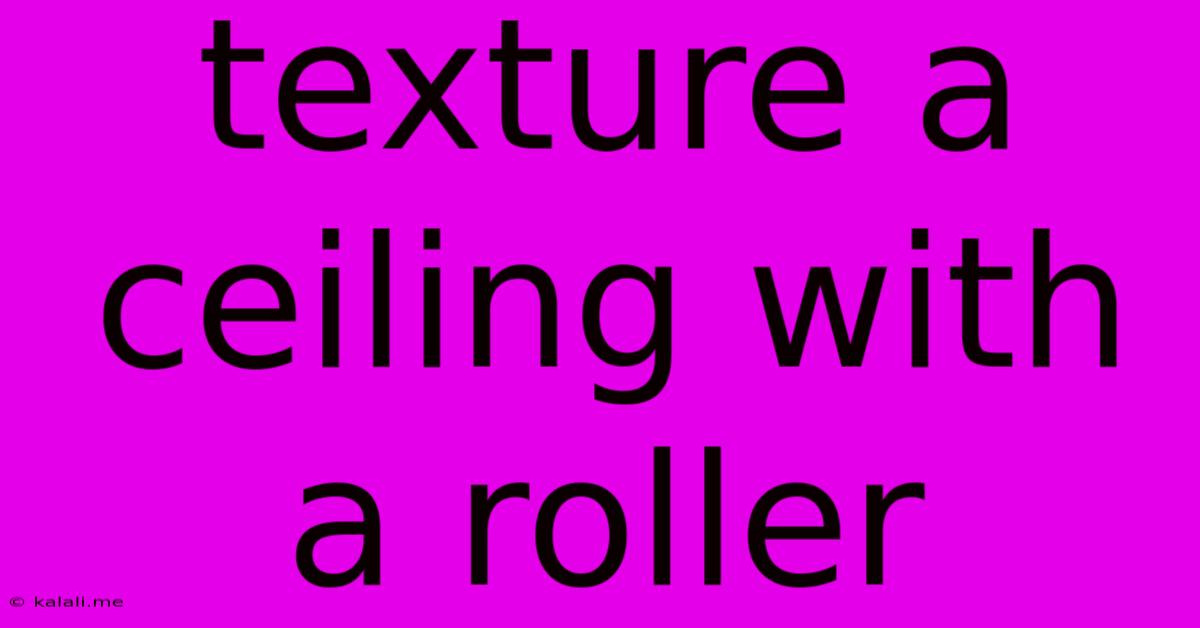Texture A Ceiling With A Roller
Kalali
May 30, 2025 · 3 min read

Table of Contents
Adding Texture to Your Ceiling with a Roller: A DIY Guide
Giving your ceiling a textured finish can dramatically transform a room's appearance, adding depth and visual interest. A textured ceiling can also help to mask imperfections and create a more sophisticated look, whether you’re aiming for a rustic farmhouse vibe or a modern minimalist aesthetic. This detailed guide will walk you through the process of texturing a ceiling using a roller, providing tips and tricks for a professional-looking result.
What You'll Need:
- Texturing Roller: Choose a roller with the desired texture pattern. Options range from simple knockdown to heavier, more pronounced patterns.
- Texturing Compound: This is available in various formulations, including those designed specifically for ceilings. Consider the level of texture you want to achieve when selecting your compound.
- Paint Tray: A large capacity tray will be necessary to hold the texturing compound.
- Mixing Bucket (optional): If your compound is thick, a bucket will make mixing easier.
- Putty Knife: For applying the compound to the roller.
- Roller Extension Pole: This is highly recommended to reach the ceiling comfortably.
- Drop Cloths/Plastic Sheeting: Protect your floors and furniture from drips and splatters.
- Painter's Tape: Secure drop cloths and protect trim work.
- Safety Glasses and Mask: Protect your eyes and respiratory system from dust and particles.
- Water (if necessary): Some compounds may require thinning with water. Always follow the manufacturer's instructions.
Preparing the Ceiling
Before you start texturing, ensure your ceiling is properly prepared. This will ensure the best possible adhesion and a smooth, even finish:
- Clean the Ceiling: Remove any loose paint, cobwebs, or debris. A light sanding might be necessary to improve the surface's grip.
- Repair Imperfections: Fill any cracks or holes with spackle or patching compound, allowing it to dry completely before proceeding. Sand smooth for a seamless finish.
- Prime the Ceiling (optional): Priming helps ensure uniform paint absorption and can improve the final texture's appearance, especially on heavily repaired surfaces.
Applying the Texture
- Mix the Compound: Follow the manufacturer's instructions carefully. If necessary, add water gradually while mixing thoroughly to achieve the desired consistency. Avoid making the compound too thin, as this could affect the final texture.
- Load the Roller: Using a putty knife, apply a generous amount of texturing compound to the roller. Ensure the compound is evenly distributed across the roller surface.
- Apply the Texture: Starting at a corner, roll the compound onto the ceiling in overlapping strokes. Maintain a consistent pressure and pace for an even application. Work in sections to avoid the compound drying before you finish.
- Knockdown Technique (if applicable): For a knockdown texture, use a separate tool (often a flat, wide trowel or a special knockdown knife) to smooth or partially remove the compound immediately after applying, creating a unique pattern. Experiment on a small area first to get a feel for the desired effect.
- Clean Up: Immediately clean your tools with water before the compound dries.
Finishing Touches
Once the textured compound has fully dried (check the manufacturer's instructions), you can proceed with painting. Choose a paint that complements your room's decor and apply it using a high-quality roller and brush for edges. Allow sufficient drying time between coats.
Remember, practicing on a less visible area before tackling the entire ceiling can help you perfect your technique and achieve the desired result. With patience and careful attention to detail, you can successfully add texture to your ceiling and enjoy the updated look of your room. This DIY project offers a cost-effective way to refresh your home's interior while improving its aesthetic appeal. Don't be afraid to experiment with different techniques and patterns to find the perfect look for your space.
Latest Posts
Latest Posts
-
Why The Fridge Is Not Cold But The Freezer Is
May 31, 2025
-
How Much Is Juice Of One Orange
May 31, 2025
-
How To Uninstall Arc Menu In Terminal
May 31, 2025
-
Can I Paint Pressure Treated Wood
May 31, 2025
-
How Many Gallons Does A Dishwasher Use
May 31, 2025
Related Post
Thank you for visiting our website which covers about Texture A Ceiling With A Roller . We hope the information provided has been useful to you. Feel free to contact us if you have any questions or need further assistance. See you next time and don't miss to bookmark.